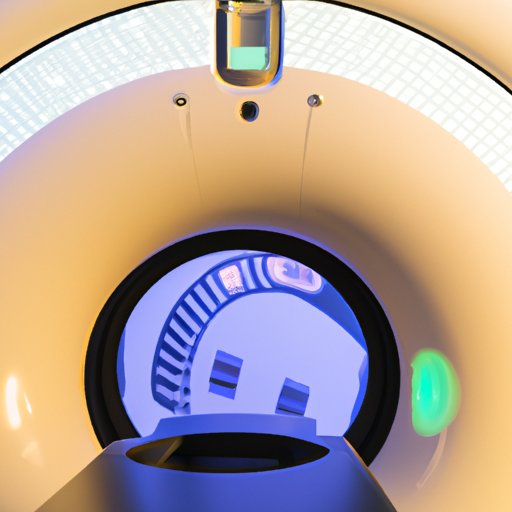Introduction
A cat scan (CT scan) is an imaging tool used by medical professionals to diagnose and monitor conditions such as tumors, infections, and trauma. A cat scan produces detailed pictures of the inside of the body, allowing doctors to accurately diagnose and treat illnesses. In this article, we’ll explore how a cat scan works and discuss the technology behind it.
Explaining the Process of a Cat Scan – A Step-by-Step Guide
The process of a cat scan consists of three main steps: preparation, scanning, and reviewing results. Let’s take a closer look at each step.
Preparation for a Cat Scan
Before a patient undergoes a cat scan, they will need to prepare for the procedure. This may involve changing into a hospital gown, removing any jewelry or metal objects, and drinking contrast material if necessary. The contrast material helps produce clearer images because it highlights certain areas of the body.
The Scanning Process
Once the patient is prepared, the cat scan can begin. During the scan, the patient lies on a table that is moved through a doughnut-shaped scanner. X-ray beams rotate around the patient, producing cross-sectional images of the body. These images are then sent to a computer for review.
Reviewing Results of a Cat Scan
After the scan is complete, the doctor will review the images and make a diagnosis. Depending on the results, the doctor may order additional tests or recommend a course of treatment.
What is a Cat Scan and How Does it Work?
A cat scan is an imaging tool that uses x-rays to produce detailed pictures of the inside of the body. The technology behind a cat scan is based on the principle that different types of tissues absorb x-rays differently. By sending x-ray beams through the body and measuring the amount of radiation absorbed, a computer can create detailed images of the body’s internal structures.
Types of Cat Scans
There are several types of cat scans available, including abdominal scans, chest scans, brain scans, and spine scans. Each type of scan is designed to provide detailed images of specific parts of the body.

Understanding the Benefits of a Cat Scan
Cat scans offer several advantages over traditional imaging techniques, including improved diagnostic accuracy, quicker diagnoses, and lower radiation exposure. Here are some of the key benefits of cat scans.
Improved Diagnostic Accuracy
Cat scans provide much more detailed images than traditional x-rays, making it easier for doctors to diagnose conditions such as tumors, infections, and fractures. This increased accuracy can lead to better treatment outcomes.
Quicker Diagnoses
Cat scans can be completed quickly, allowing doctors to diagnose and treat conditions in a timely manner. This can reduce the risk of complications and improve patient outcomes.
Lower Radiation Exposure
Cat scans use far less radiation than traditional x-rays, reducing the risk of radiation-related health problems. This makes them a safer option for patients who require frequent imaging tests.
The Latest Advances in Cat Scan Technology
Cat scan technology is constantly evolving, with new advances designed to improve imaging capabilities, automate diagnoses, and increase patient comfort. Here are some of the latest developments in cat scan technology.
Enhanced Imaging Capabilities
Recent advancements in cat scan technology have enabled doctors to produce even more detailed images of the body. This can help doctors diagnose conditions more accurately and provide better treatment plans.
Automated Diagnostics
New software programs can analyze cat scan images and automatically detect abnormalities, eliminating the need for manual analysis. This can save time and improve diagnostic accuracy.
Improved Patient Comfort
Cat scan machines have become quieter and more comfortable for patients, making it easier for them to remain still during the scan. This can reduce discomfort and improve the overall experience.
Conclusion
Cat scans are a valuable tool in medical diagnosis and treatment. They offer improved diagnostic accuracy, quicker diagnoses, and lower radiation exposure than traditional imaging techniques. Recent advancements in cat scan technology have made the procedure even more effective, with enhanced imaging capabilities, automated diagnostics, and improved patient comfort. If you have any questions about cat scans, talk to your doctor.
(Note: Is this article not meeting your expectations? Do you have knowledge or insights to share? Unlock new opportunities and expand your reach by joining our authors team. Click Registration to join us and share your expertise with our readers.)
